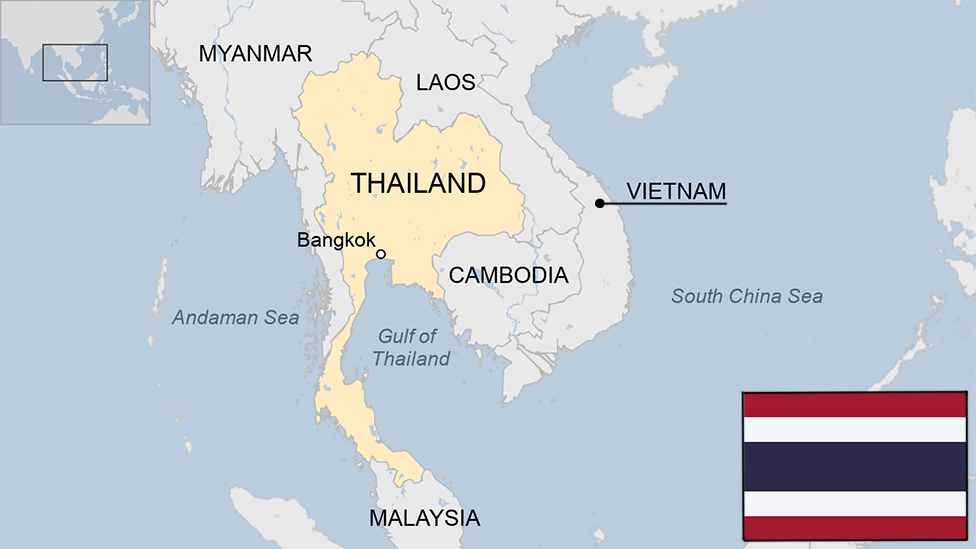Thailand tiger farms: Hunting the traffickers
- Published
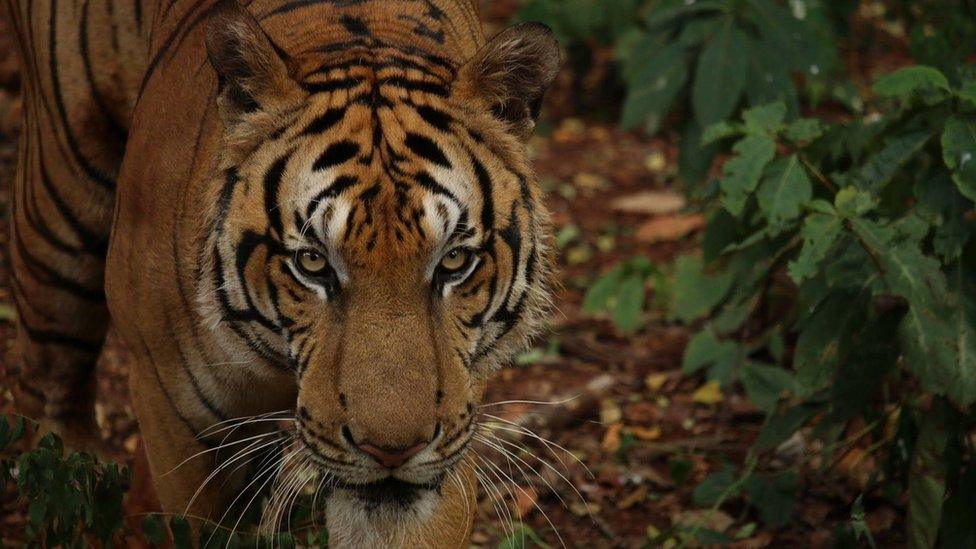
Tiger farms are not illegal in Thailand but they are very loosely regulated
When the Thai authorities moved in to shut down a tiger zoo in a temple at the end of May, they exposed a lot more than just the various irregularities in that one facility. The macabre sight of tiger foetuses preserved in bottles, and the shrivelled, frozen remains of other cubs, suddenly cast the popular tourist attraction into a more sinister light. Was this evidence of illegal trade in tiger parts?
As it happens, few experts believe the cub carcasses have much value. The bones, skin, teeth, claws and meat of adult tigers are where the money is made. Officials of Thailand's Department of National Parks, who closed the temple zoo and removed its 147 tigers, did find some evidence of trafficking: amulets containing tiger claws, and a truck attempting to leave the temple with two skins and other small parts. At least three adult tigers had gone missing two years earlier.
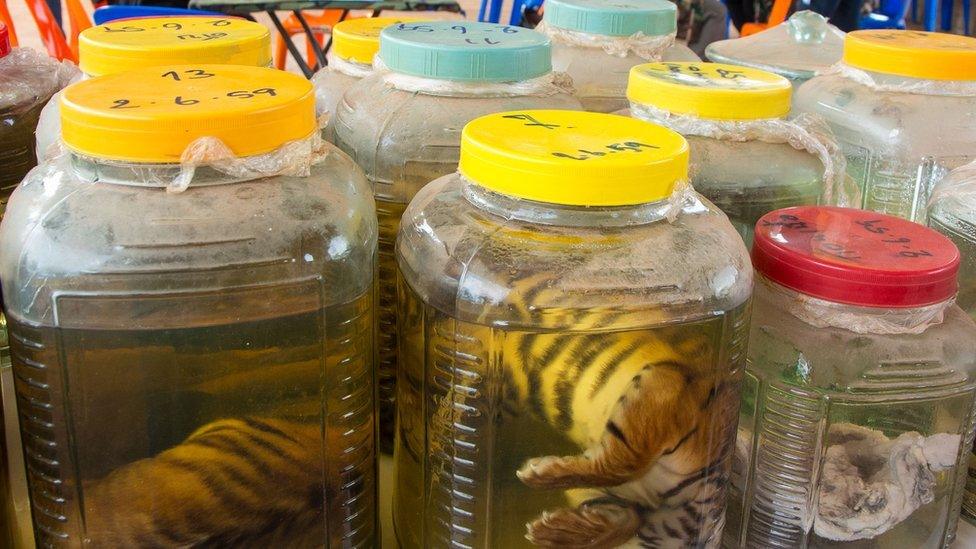
Dead tiger cubs in jars were found at the tiger temple.
This, said DNP Deputy Director Adisorn Noochdumrong, suggested continuous involvement in small-scale illegal trafficking by the temple's managers. But his bigger concern is the criminal networks he believes have been encouraging the trade, from this and other so-called "tiger farms". There are at least 30 such farms in Thailand, where intensive breeding takes place. They are not illegal but the lack of records in the temple zoo illustrates the weak regulation of these places and allows the possibility of tiger trafficking.
"I am quite certain there is a network behind what he have discovered at the temple," said Adisorn. "The temple would not run this alone but tiger trading is hard to verify. The networks are sophisticated and hard to monitor. Influential people are involved."
Adisorn and his team have tried to trace the origins of the impounded tigers through their DNA. He believes there are seven original parent animals, two Siberian tigers, one Malayan tiger and four that died some years ago, for which he has no information.
All tigers must be registered with the DNP under Thai law and agreements upheld by Cites, an international treaty to protect endangered species from irresponsible trading., external All deaths, births and transfers must also be recorded. But this was not happening. Any argument that breeding these particular tigers was to help in their conservation makes no sense, as they are a mix of different subspecies.
International pressure
Thailand is a hub for the illegal wildlife trade, funnelling endangered animals from Africa and other parts of Asia through neighbouring Laos, where law enforcement is especially weak, and on to Vietnam and China, where the demand is. International pressure has pushed the Thai authorities to become more active in intercepting contraband wildlife shipments but little is being done to break up the syndicates running the trade. Very few arrests have been made.
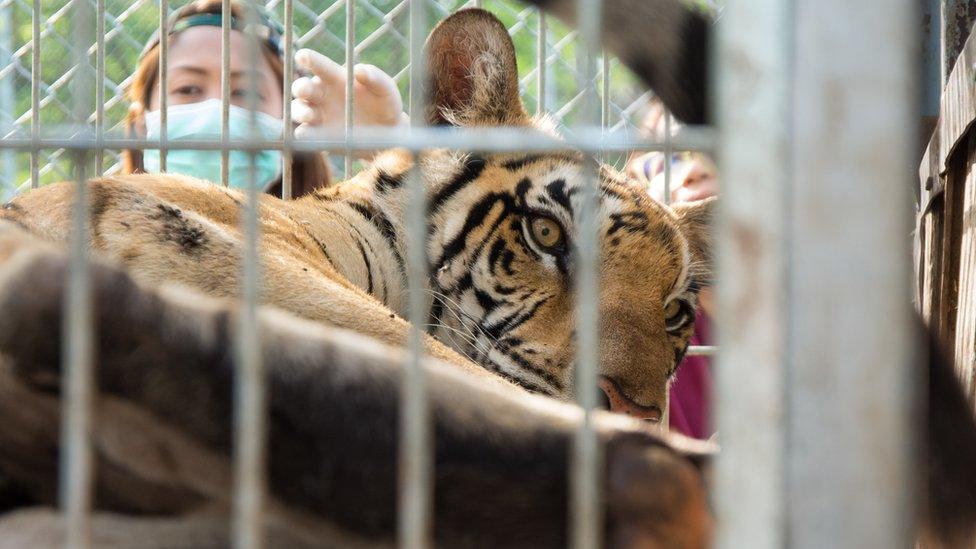
A tiger coming round after being drugged at the Tiger temple.
Campaigners monitoring the trade say "farmed" tigers are brought into trafficking all too easily because of the lack of regulation and enforcement. It is difficult to tell whether a carcass belongs to a wild or captive tiger but Thai officials believe at least 30% of those being trafficked come from a captive origin. Often they will be drowned in special submersion cages to avoid damaging the valuable skin. Traffickers then "float" the wrapped carcasses in the Mekong river from the Thai side and have them picked up by smugglers on the Laotian side.
Thai Tiger Temple's long history of controversy
Edwin Wiek, who runs an NGO trying to protect threatened wildlife in Thailand, explains why trading captive tigers matters so much to conservationists: "To stop the trade, these tiger farms need to be closed down - not only the tiger temple but all the other ones as well.
"So that we can say that when tigers are being traded, that we are absolutely sure they are from the wild, and we can do something about it. Breeding a tiger, caring for a tiger until it is an adult costs a lot of money."
He estimates the cost of a farm tiger at $7,000 to $8,000 (£5,600-£6,500).
"When a poacher goes into the jungle he can kill a tiger with one or two bullets, which will be a lot cheaper," he says.
"So there is a big chance the wild populations are being touched for the same market as captive animals."
The population of captive tigers in Thailand is now estimated to be around 1,500. When the growing numbers being kept in Laos, Vietnam and China are added, the total captive population in this region exceeds the entire world population of wild tigers, which is around 3,800.
Big profits from big animals
The economics of tiger farming are baffling and inevitably raise suspicions that some captive animals must be siphoned off for slaughter, in violation of Cites rules. An adult tiger consumes between four and eight kilos of meat a day (9 to 17 lb). An internal Laotian government report, seen by the BBC, openly acknowledges that a tiger farm near the Laotian border town of Thakhek was, until recently, killing 100 tigers a year for commercial use.
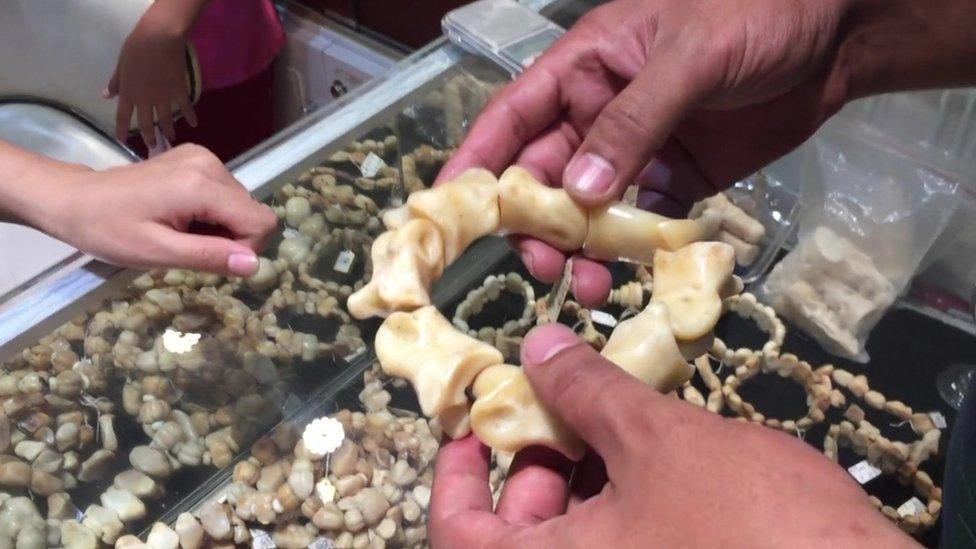
A BBC correspondent found bracelets made from tiger bones being traded in Myanmar's Wa region in November
At Thailand's biggest tiger zoo, Sri Racha, south of Bangkok, the tiger population reached 447 at one point, falling to 323 today. The management there argues that the ideal population is 350. Only a fraction of those can be seen by visitors, via performing tiger shows and - the most popular activity - feeding tiger cubs, which helps explain the huge populations.
Tiger produce found on sale in Myanmar
Tanya Erzinclioglu is a British volunteer who worked at the tiger temple for six years, becoming a self-taught expert on the animals and, she says, trying to ensure their welfare was protected. She believes they were well-treated there, and that any involvement in trafficking was small-scale. But the breeding, she says, was out of control.
"I hated it," she recalls.
"When I first arrived there were 70. By the time we left I'd known 150-plus tigers. That's a double increase in six years, it's ridiculous. We could change a lot of things there, but this was one of the hardest because they thought they made so much money from the cub-feeding, and tourists want the cute babies. And they would come, and the babies were already 10 months old, and then they don't think it's cute, and they write bad reviews. So the management would ask 'why aren't there any cubs?'"
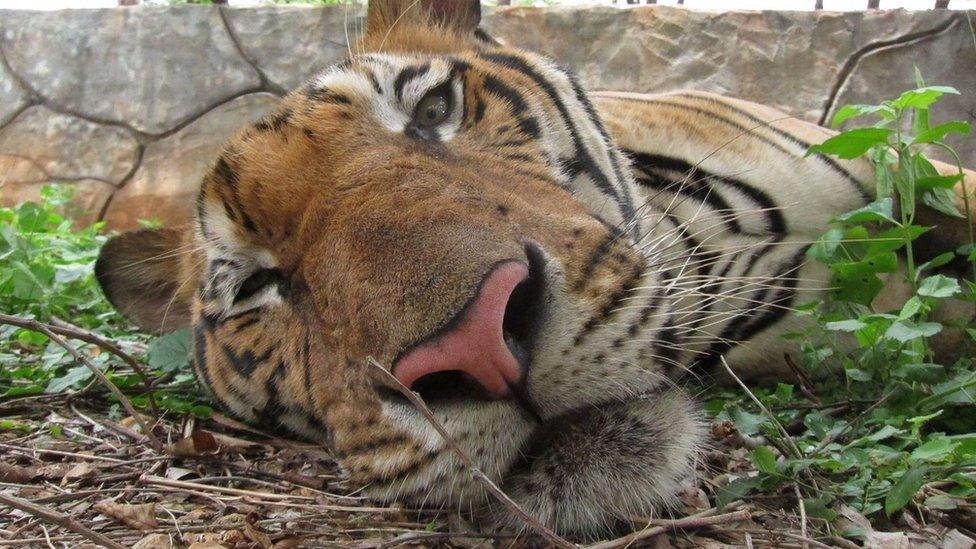
Tigers in captivity are sometimes made to perform in shows for tourists.
Adisorn Noochdumrong and his colleagues at the Department of National Parks are now compiling a database of all captive tigers in Thailand, recording their DNA profiles and distinctive stripe patterns, so that they can be properly traced if they go missing.
But there are growing calls now from international groups like the WWF to end tiger farming altogether. The Laotian government has already promised to do this, although whether that actually happens is still in question, given the record there of official tolerance for trafficking. If other countries like Thailand follow suit - and there are officials here now openly arguing for the farms to shut, and just zoos, with mixed animal populations to remain open - that would close one loophole through which the trade in endangered species is able to continue.
- Published1 June 2016
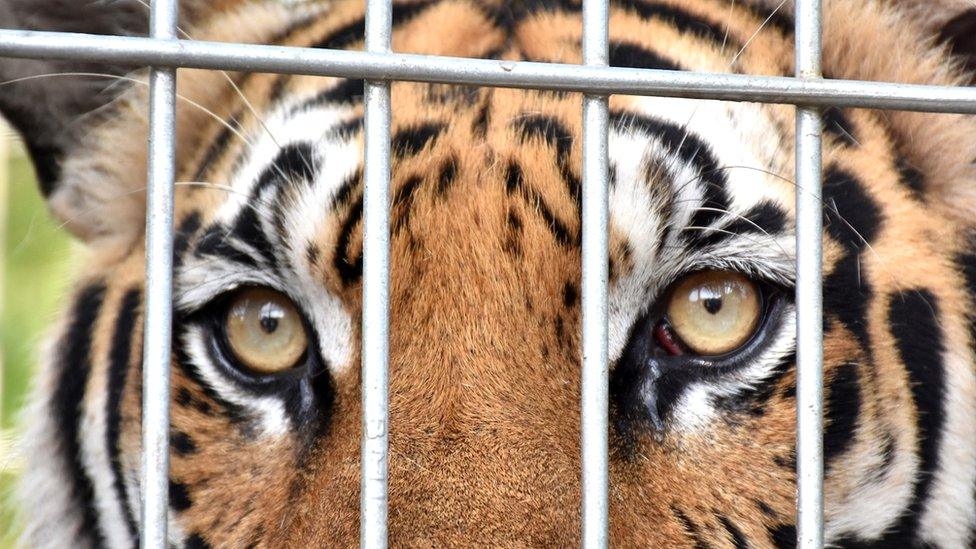
- Published1 June 2016
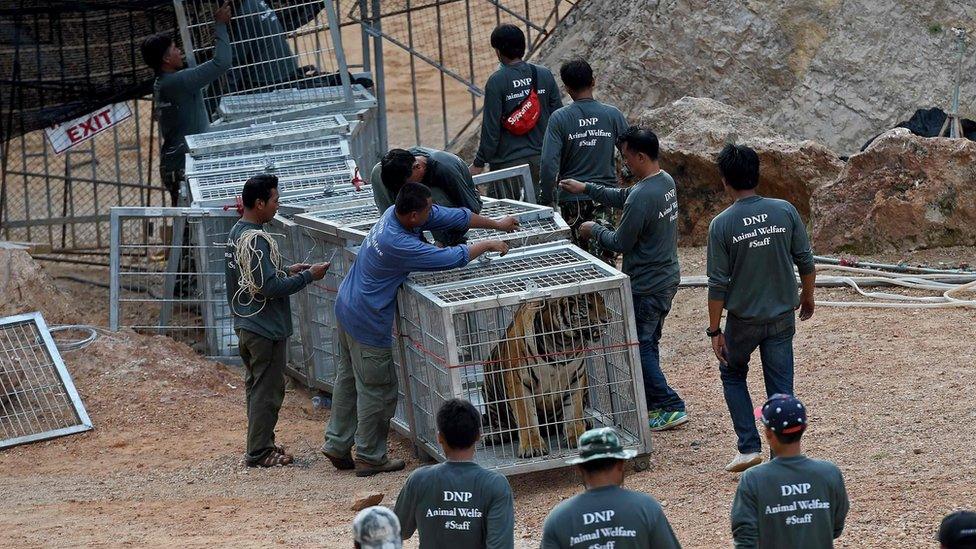
- Published31 May 2016
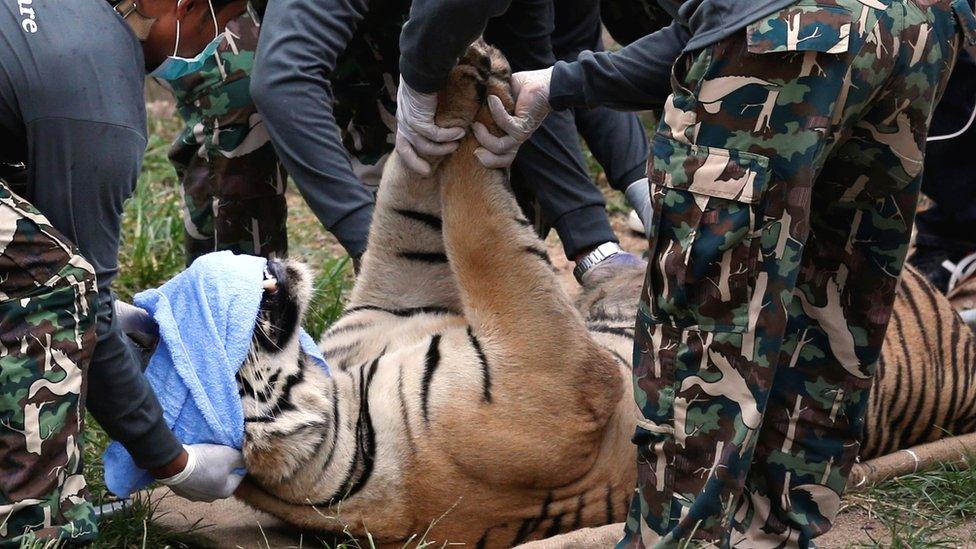
- Published17 November 2016

- Published16 August 2024
